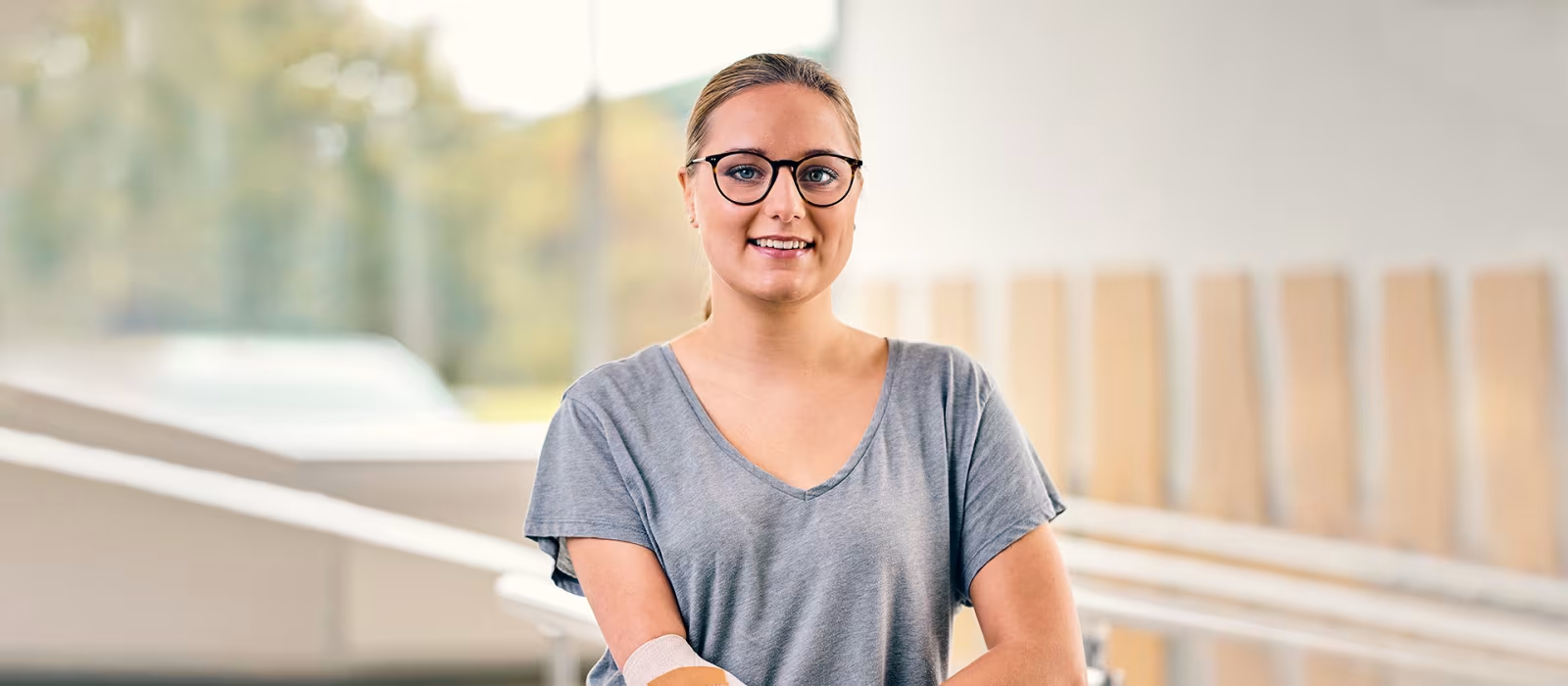


Amputation rehab: What to expect
The rehabilitation process is critical for anyone who has recently lost a hand or arm. Find out how it can help heal your residual limb, restore your mobility, and prepare you for a prosthetic arm.
The rehabilitation process is critical for anyone who has recently lost a hand or arm. Find out how it can help heal your residual limb, restore your mobility, and prepare you for a prosthetic arm.
Healing, training, and preparing for a prosthesis
After your amputation surgery, recovery and healing are your top priorities. The rehabilitation process is an essential part of this time. Together with your care team, you’ll focus on rebuilding your strength, carefully caring for your residual limb, and taking the first steps toward using a prosthetic arm.
Amputation rehab begins as soon as possible after your operation, and typically lasts about six month. During that time, your care team will create a detailed plan to heal your residual limb and get you ready for your prosthesis. You’ll also need to start preparing yourself for everyday life with your new upper limb difference.
This article will guide you through some of the key steps in that process. Just remember: everyone’s experience will be different. Your care team will help you understand which activities like these are most important for you.
Keep reading to learn more about how amputation rehab helps:
Heal your residual limb as quickly and successfully as possible
Strengthen parts of your body affected by your amputation
Prepare you to use a prosthetic device*
*This article focuses on devices for users who’ve had a transhumeral amputation. If you’ve had a different procedure, your prosthetist can provide you with more information on higher amputation levels.
Reducing edema in your residual limb
The first steps in amputation rehab begin immediately after your operation. In the days after amputation surgery, your hospital care team will closely monitor your wound, carefully watch for any sign of infection, and ensure that your residual limb begins to heal properly.
One of the most important changes your care team will focus on is swelling, or “edema.” Edema is a normal reaction to an amputation operation, and will typically go down over time. But if it lasts too long, it can slow down your healing and make it harder to fit a prosthesis. Right after surgery, you and your care team will start working together to make sure any swelling goes down over time.
Early edema management
At first, your hospital care team will only losely bandage your residual limb to avoid putting any additional pressure on your wound and stitches. They’ll regularly change this bandage as they monitor you.

Starting compression therapy
Once your doctor or surgeon decides you’re ready, your care team will then wrap your wound in a tighter dressing that fits snugly to your residual limb. This is called “compression therapy,” which helps reduce pain, heal your scar, improve blood flow, and reduce swelling. It also helps shape your residual limb for your future prosthetic.
Your care team will typically apply this helpful pressure one of two ways.
Compression bandage
This adjustable elastic bandage is designed to wrap around your residual limb, applying firm pressure that decreases toward your body. The wrap can then be adjusted as needed throughout the day.
Putting on a compression bandage can take some practice and experience. In most cases, someone on your care team will help you apply it at first, then teach you how to do so yourself. A compression bandage should never be painfully tight or cut off feeling in your residual limb.
Silicone liners
These devices are a quick, easy-to-use alternative to a compression bandage, and come in many ready-made sizes.
If you and your care team decide to try a silicone liner, always make sure that no air is trapped at the end of the liner once you put it on. This will help ensure your liner applies pressure to your wound as evenly as possible.
You may also find that your residual limb sweats more when you wear a silicone liner. This typically stops after you’ve gotten used to the device. To avoid skin irritation, try applying a product like Ottobock Derma Prevent to your skin at the edge of the liner. Make sure you also clean your liner regularly according the instructions for use.

Later compression therapy
Your care team will typically have you continue compression therapy until they can tell that your residual limb is no longer changing size (a sign that the swelling is gone). During this time, they’ll train you or your caregiver to use your compression bandage or silicone liner at home.
Once your care team decides you can stop compression therapy, you’ll be ready for an important new step: trying out your first prosthesis!

Preparing to use a prosthetic arm
While you and your care team are working to manage any post-surgical swelling in your residual limb, you’ll also start taking the first steps toward using a prosthesis.
These steps typically include:
Strengthening and stretching muscles in your residual limb, shoulder, back, and torso
Any training you may need to use your remaining hand and arm (your “sound side”) in new ways
Here are a few key areas you and your care team will probably focus on.
Positioning your residual limb
After surgery, you’ll naturally want to put your residual limb in the most comfortable, least painful position possible. You may rest it on a pillow or prop it up in some way.
While this may help reduce your pain at first, it can also cause your remaining arm muscles to shorten and stiffen. This can limit the amount of mobility you’re able to achieve later on. Over time, your hospital care team will encourage you to leave your residual limb extended by your side as much as possible when you’re not exercising or caring for it.

Strengthening your residual limb
As soon as possible after your surgery, your care team will also encourage you to start moving your residual limb a few times every day. This exercise can help improve your mobility, balance, and circulation, and also help you achieve the greatest range of motion possible once you start using a prosthetic.
It’s particularly important to get your shoulder moving again (if possible), because it may otherwise stiffen and limit your ability to move your arm. Your care team will show you how to move and position your residual limb in ways that best support your recovery, healing, and preparation for a prosthesis.

Strengthening supporting muscles
As you start to move your residual limb again, you may notice that having an upper limb difference can affect other parts of your body too.
For example, it’s normal to feel some strain on your back. That’s because your body’s weight and balance have shifted and your muscles need time to get used to the change.
You can help by regularly exercising your upper body, shoulders, torso, and legs. Doing so can help your body adapt to its new balance, strengthen important muscles that support your residual limb, and set you up for greater independence after your recovery.

Training your sound side
After you lose a hand or arm, you may soon find you need to rely on your remaining limb in many new ways (especially if you’ve lost your dominant hand).
As you work on strengthening your residual limb, your care team will also show you some useful ways to build new skills on your sound side. These may include important daily activities – like brushing your teeth, typing, or using a smartphone – that you may want to be comfortable doing one-handed.

Supporting your healing wound
In most cases, amputation wounds close in three to four weeks and then start forming a scar. But while your scar may look like it has healed after a few weeks, the full healing process takes much longer – typically about eighteen months.
During that time, caring for your skin and scar is a top priority. A few key steps can help you ensure your residual limb heals successfully, and that it’s ready for a prosthesis when you’re ready to start using one.
Desensitizing your skin
After your amputation, the skin on your residual limb may be uncomfortably sensitive. There are a few ways you can reduce that discomfort:
Gently rub or tap your skin with a soft brush or a spiky massage ball. This will help slowly increase the amount of pressure your skin can take.
Gently rub down your residual limb with a bathtowel or washcloth.
Whichever you try, aways start at the end of your residual limb and work toward your body.

Cleaning your skin
Keeping your residual limb clean is also very important. Wash it every day with lukewarm water and an unscented, skin-friendly soap.
Ottobock offers several care products that can help you clean your skin or scar. Or, you can ask your prosthetist for recommendations.

Caring for your scar
Regularly moisturize your scar and the skin around it. Scars can’t produce the moisture that typically keeps your skin soft and flexible, which it will need to be when you start wearing a prosthesis. Prosthesis and rough, dry skin can be a painful combination, one that makes it much harder for you to consistently wear your device.
Unscented moisturizing creams are often a good choice. Ask your prosthetist for their recommendation. They’re always the best place to start when you need advice on how to get the most out of your prosthesis!
See what’s next for your journey with an upper limb difference

Preparing for your amputation surgery
An amputation is a major medical procedure that your care team will carefully plan and prepare you for. Find out what to expect from that important process.
An amputation is a major medical procedure that your care team will carefully plan and prepare you for. Find out what to expect from that important process.

Learning to use a prosthetic arm
A prosthetic arm can make a big difference in your day-to-day life, but learning to use one takes lots of practice. Find out how to pick the right device and get the most from it.
A prosthetic arm can make a big difference in your day-to-day life, but learning to use one takes lots of practice. Find out how to pick the right device and get the most from it.

Exploring bionic life stories
Discover a truly remarkable group of people who've come together to share their experiences, their inspiration, and their tips and tricks for living an empowered life with a bionic hand. Come explore their inspiring stories — and share yours!
Discover a truly remarkable group of people who've come together to share their experiences, their inspiration, and their tips and tricks for living an empowered life with a bionic hand. Come explore their inspiring stories — and share yours!
